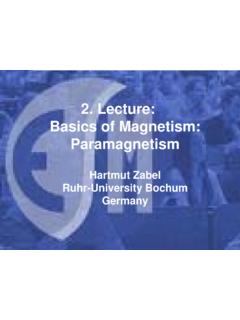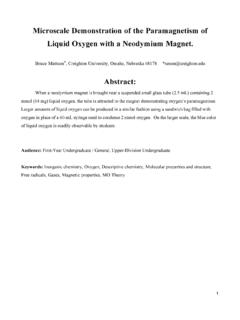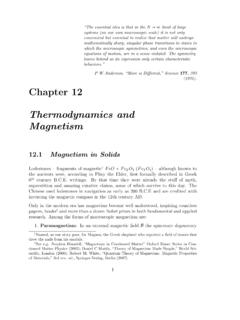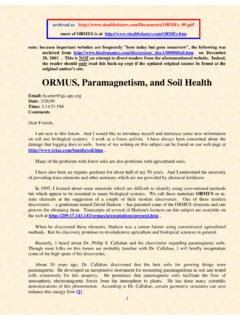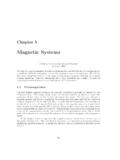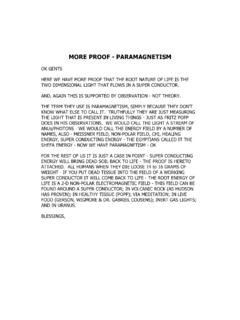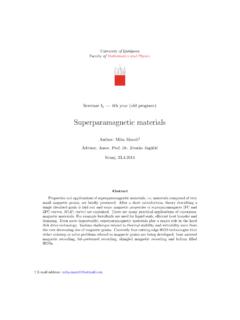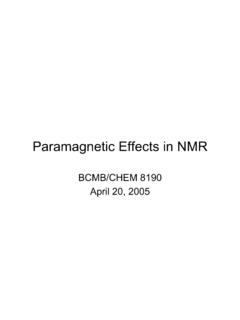Transcription of Introduction to MRI - Washington State University
1 Introduction to MRI Welcome to the exciting world of MRI! This is a tutorial that will cover the basic aspects of MRI. Copyright 1994-1998 Ray Ballinger, All Rights Reserved. Send questions and comments to Ray Ballinger at mridoc@ : Version Conversion done by Markus Busoldof "The International NMR Resource site"URL: Modified: September 22, 1998 Basics of MRI Instrumentation Image Characteristics Artifacts Pulse sequences Safety Contrast Agents MR Angiography MR Spectroscopy Special Topics Glossary References Basics of MRI The following topics will be discussed: Magnetism Resonance and RF Relaxation References Magnetism Magnetism is a property of matter that is a result of the orbiting electrons in atoms.
2 The orbitingelectrons cause the atoms to have a magnetic moment associated with an intrinsic angular momentumcalled 'spin'. Magnetic field strengths are measured in units of gauss (G) and Tesla (T). One Tesla isequal to 10,000 gauss. The earth's magnetic field is about gauss. The strength of electromagnetsused to pick up cars in junk yards is about the field strength of MRI machines ( ). You willrun across four terms describing the magnetic properties of materials, such as contrast agents, used inMRI. These terms are ferromagnetism, paramagnetism , superparamagnetism, and diamagnetism Ferromagnetism paramagnetism Superparamagnetism Diamagnetism Ferromagnetism Ferromagnetic materials generally contain iron, nickel, or cobalt.
3 These materials include magnets,and various objects one might find in a patient, such as aneurysm clips, parts of pacemakers, shrapnel,etc. These materials have a large positive magnetic susceptibility, , when placed in a magnet field,the field strength is much stronger inside the material than outside. Ferromagnetic materials are alsocharacterized by being made up of clusters of 10^17 to 10^21 atoms called magnetic domains, that allhave their magnetic moments pointing in the same direction. The moments of the domains is randomin unmagnetized materials, and point in the same direction in magnetized materials. The figure to theabove illustrates the effect of a ferromagnetic material (grey circle) on the magnetic field flux lines(blue).
4 The ability to remain magnetized when an external magnetic field is removed is a distinguishingfactor compared to paramagnetic, superparamagnetic, and diamagnetic materials. On MR images,these materials cause susceptibility artifacts characterized by loss of signal and spatial distortion. Thiscan occur with even fragments to small to be seen on plain x-ray. This is a common finding in acervical spine MRI post anterior fusion. paramagnetism Paramagnetic materials include oxygen and ions of various metals like Fe, Mg, and Gd. These ionshave unpaired electrons, resulting in a positive magnetic susceptibility. The magnitude of thissusceptibility is less than one one-thousands of that of ferromagnetic materials.
5 The effect on MRI isincrease in the T1 and T2 relaxation rates (decrease in the T1 and T2 times). The figure aboveillustrates the effect of a paramagnetic material (grey circle) on the magnetic field flux lines (blue). Gdis used as a in MR contrast agents. At the proper concentration, Gd contrast agents cause preferentialT1 relaxation enhancement, causing increase in signal on T1-weighted images. At high concentrations,as is sometimes seen in the urinary bladder, loss of signal is seen instead, a result of the T2 relaxationeffects dominating. Superparamagnetism Superparamagnetic materials consist of individual domains of elements that have ferromagneticproperties in bulk.
6 Their magnetic susceptibility is between that of ferromagnetic and paramagneticmaterials. The figure to the left illustrates the effect of a superparamagnetic material (grey circle) onthe magnetic field flux lines (blue). Examples of a superparamagnetic materials include iron containingcontrast agents for bowel, liver, and lymph node imaging. Diamagnetism Diamagnetic materials have no intrinsic atomic magnetic moment, but when placed in a magnetic fieldweakly repel the field, resulting in a small negative magnetic susceptibility. Materials like water,copper, nitrogen, barium sulfate, and most tissues are figure above illustrates theeffect of a diamagnetic material (grey circle) on the magnetic field flux lines (blue).
7 The weak negativemagnetic susceptibility contributes to the loss of signal seen in bowel on MRI after administration ofbarium sulfate suspensions. Resonance and RF Protons in a magnetic field have a microscopic magnetization and act like tiny toy tops that wobble asthey rate of the wobbling or precession is the resonance or Larmor frequency. In themagnetic field of an MRI scanner at room temperature, there is approximately the same number ofproton nuclei aligned with the main magnetic field Bo as counter aligned. The aligned position isslightly favored, as the nucleus is at a lower energy in this position. For every one-million nuclei, thereis about one extra aligned with the Bo field as opposed to the field.
8 This results in a net ormacroscopic magnetization pointing in the direction of the main magnetic field. Exposure of individualnuclei to RF radiation (B1 field) at the Larmor frequency causes nuclei in the lower energy State tojump into the higher energy State . On a macroscopic level, exposure of an object or person to RF radiation at the Larmor frequency,causes the net magnetization to spiral away from the Bo field. In the rotating frame of reference, thenet magnetization vector rotate from a longitudinal position a distance proportional to the time lengthof the RF pulse. After a certain length of time, the net magnetization vector rotates 90 degrees andlies in the transverse or x-y plane.
9 It is in this position that the net magnetization can be detected onMRI. The angle that the net magnetization vector rotates is commonly called the 'flip' or 'tip' angle. Atangles greater than or less than 90 degrees there will still be a small component of the magnetizationthat will be in the x-y plane, and therefore be detected. Relaxation T1 Relaxation The return of excited nuclei from the high energy State to the low energy or ground State is associatedwith loss of energy to the surrounding nuclei. Nuclear magnetic resonance was originally use toexamine solids in the form of lattices, hence the name "spin-lattice" relaxation. Macroscopically, T1relaxation is characterized by the longitudinal return of the net magnetization to its ground State ofmaximum length in the direction of the main magnetic field.
10 The rate of return is an exponentialprocess as is shown in the following figure. The T1 relaxation time is the time for the magnetization to return to 63% of its original length. Aftertwo T1 times, the magnetization is at 86% of its original length. Three T1 times gives 95%. Spins areconsidered completely relaxed after 3-5 T1 times. Another term that you may hear is the T1 relaxationrate. This is merely the reciprocal of the T1 time( 1/T1). T1 relaxation is fastest when the motion ofthe nucleus (rotations and translations or "tumbling rate") matches that of the Larmor frequency. As aresult, T1 relaxation is dependent on the main magnetic field strength that specifies the Larmorfrequency.

